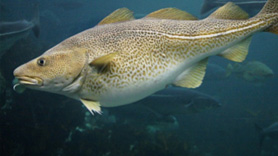February 14th, 2014
Key Findings
- Climate projections from GFDL’s ESM2.1 are used to force an individual-based model of North Atlantic Cod larvae at each of 5 cod spawning sites across the North Atlantic.
- Projections suggest that warming and reduced food resources for larvae under climate change may lead to lower larval survival rates if the density of predators of cod larvae is maintained.
- In the past, cod stocks near the cold-water limits of the species range exhibited increased survival rates during warm anomalies. In the lower prey environment projected under climate change, however, the disadvantage of higher metabolic costs in warm waters may outweigh the advantage of higher growth potential and lead to lower survival rates.
Trond Kristiansen (Institute of Marine Research, Bergen), Charles Stock (NOAA/GFDL), Ken Drinkwater (IMR/Bergen), Enrique Curchitser (Rutgers). Mechanistic insight into the effects of climate change on larval cod. Journal: Global Change Biology. DOI: 10.1111/gcb.12489
Summary
This study uses climate projections from GFDL’s Earth system model (ESM2.1) to force an individual-based model for the larval stages of North Atlantic Cod at each of 5 cod spawning sites across the North Atlantic. The behavioral and physiological state of thousands of cod larvae is modeled in response to ESM projected physical and biological changes. The ESM-IBM coupling provides a unique means of exploring the mechanistic response of cod larvae to climate forcing.
Under the SRES A2 (high emissions) scenario, surface ocean temperatures are projected to increase by > 1oC for 3 of the 5 regions and stratification is expected to increase at all sites between 1950-1999 and 2050-2099. These changes are associated with decreased primary production by large phytoplankton and reduced mesozooplankton biomass (the primary prey for larval cod). Higher temperatures increase larval metabolic costs, which combine with decreased food resources to reduce larval weight and increased susceptibility to invertebrate predation during some seasons.  Where larvae can maintain weights, they must do so by foraging in shallower, well-lit areas of the water column, increasing exposure to predation by fish. If predator biomass remains constant, a decline in larval cod survival results.
Where larvae can maintain weights, they must do so by foraging in shallower, well-lit areas of the water column, increasing exposure to predation by fish. If predator biomass remains constant, a decline in larval cod survival results.
Past observed responses to climate variability suggest that warm anomalies led to more larval fish eventually entering the fishable stock (higher recruitment) for Atlantic cod stocks near the cold-water (northern) limits of their present range (e.g., Iceland and the Barents Sea). This response is thought to result from the association of high food resources with these past anomalies and enhanced growth potential during warm anomalies in these regions. Our climate change projections suggest that reduced food resources for larvae under climate change may lead to a negative response to warming throughout the species range: in the lower prey environment, higher metabolic costs due to higher temperatures outweigh the advantages of higher growth potential, leading to negative effects on cod larvae.
There are several notable limitations to the analyses in this paper that must be addressed in future work. First, the survival of cod larvae depends on the condition of the larvae and larval predation. Strong declines in predators can offset the negative effects of larval condition on larval survival. Second, the coarse resolution (~1 deg. Latitude/Longitude) of present global Earth System Models (ESMs) prevents analysis of local-scale processes that could significantly modify, or reverse, trends resulting from the large-scale changes analyzed herein. Third, while ESM’s from different modeling centers exhibit fairly consistent projected changes in temperature and productivity over the North Atlantic, trends can vary at smaller scales. While this study is a significant step toward a more complete understanding of the effects of climate change on Atlantic Cod, these limitations must be addressed to improve quantitative confidence in projected changes.


